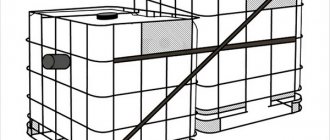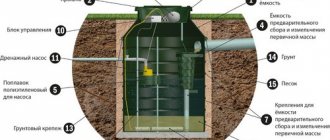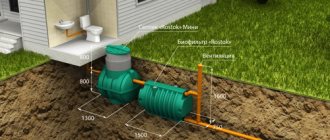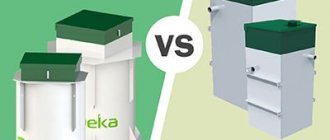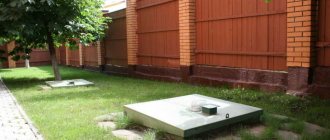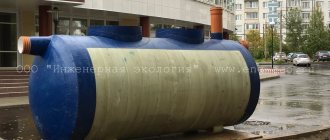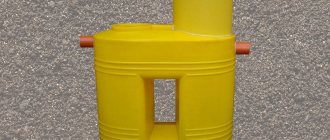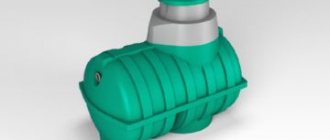- Sewerage
- biotank
The autonomous sewage system "Biotank" from, characterized by its compact size and reliable design, will provide you with comfort for many years! This is a non-energy-independent biological wastewater treatment plant, which is perfect not only for a summer house intended for seasonal living, but also for houses where people live permanently.
In the manufacturer’s line, everyone will be able to choose a suitable model, based on the number of people living in the house. In addition to volumes, Biotank septic tanks can differ in several other parameters. For example, if you need to place an autonomous sewer system in a small area, a vertical septic tank that is installed in a deep pit is suitable for you. If there are no space restrictions, you can choose horizontal models.
Both vertical and horizontal models can have a forced discharge of purified water onto the terrain or be gravity-fed. These series are marked with letter designations - “PR” and “SM”, respectively.
Design features of Biotank septic tanks
The Biotank installation has a rectangular cast body, divided into four chambers. In each of them, one of the stages of wastewater treatment occurs:
- The first chamber is the primary settling tank, in which solid particles settle.
- The second chamber includes an aerator with a floating load and biofilm. Here the process of oxidation of contaminants to nitrites and nitrates occurs.
- The third chamber is a secondary settling tank, where clean water is separated from the biofilm. The sediment accumulated at the bottom is transported from the third chamber to the first by means of an airlift for further continuous cleaning.
- The fourth chamber is a biofilter operating on the principle of a hydrocyclone. It gravity-fed or forcibly directs purified water to be discharged onto the ground.
At the exit, the degree of wastewater purification reaches indicators corresponding to sanitary standards - 95-98%.
Owner reviews and disadvantages
No sewerage installation can be called ideal, which is why the Biotank septic tank also has negative reviews. Many users share their impressions of the selected devices, which allows them to highlight negative aspects and try to avoid a bad experience.
Among the minuses it is worth highlighting:
- Dependence on power supply. The system runs on electricity. In addition, using a septic tank increases utility costs.
- Severe frosts may interfere with the operation of the device. If the weather in the area where the septic tank is installed is quite cool, it must be insulated for the winter. Otherwise, ice jams will occur and the sewer system will not work.
- Despite the high efficiency of the system, it is impossible to water the garden or vegetable garden with water after cleaning.
You can read many negative reviews about septic tanks on the Internet. Mostly, users complain about constant breakdowns and an unpleasant odor. Parts of the device may break due to improper installation or operating errors. An unpleasant odor usually occurs when a large amount of antibacterial substances (for example, chlorine) has been released into the water. The malfunction can be eliminated by unscheduled pumping out the waste and washing the chambers.
Advantages of Biotank septic tanks
- Suitable for installation on any soil – even clayey ones with a high groundwater level.
- Withstands toilet paper, as well as organic and chemical detergents in small quantities, getting into the sewer.
- In the event of a power outage, they can work autonomously for some time.
- They do not emit unpleasant odors.
- Maintenance is required every 1-3 years.
- The simplicity of the design minimizes the possibility of breakdown.
Types of bioseptic tank
The manufacturer offers a wide range of treatment facilities. The Traditional Tank is a simple design with low cost. The system is selected depending on the load, i.e., the number of users.
You can install a Biotank septic tank yourself, but you should first familiarize yourself with the theory
The choice of septic tank is also influenced by:
- Soil area;
- Groundwater level;
- Soil type.
If an ordinary Tank is a plastic box, then a Biotank is a modern wastewater treatment plant. It is divided into two subtypes: horizontal and vertical. A horizontal septic tank consists of universal buildings. It is installed in large areas where there are no restrictions on the size of the pit. The vertical model is designed for small areas where it is necessary to dig a narrow but deep pit.
For each subtype of the system there are two more modifications. One provides for gravity discharge of water, the other - forced discharge using a pump.
When purchasing a septic tank, pay attention to the labeling. The modification with gravity emission is marked CAM, with forced emission - PR.
Models also vary in size and performance. So, for example, the Tank-4 bioseptic tank is designed for a maximum of 4 users, its productivity is 800 l/day. The choice of device depends directly on how often it will be used. So, for a dacha they choose small structures that operate without electricity, while for a country house a structure with a biofilter and a high level of purification is required.
Description
Biotank septic tanks are energy-dependent models; they operate when the power supply is connected. A special feature of the model is its low sensitivity to power outages.
Advice! According to reviews, the station is capable of providing a normal level of water purification within 24 hours after a power outage (at a moderate flow rate).
Specifications
Here are the main technical characteristics of the septic tank model:
- number of users – 1-4;
- maximum daily consumption in the house is 800 liters;
- overall dimensions (for a vertical septic tank) – 1.2 x 1.0 x 2.105 meters;
- Dimensions (for a horizontal septic tank) – 1.2 x 1.2 x 1.85 meters.
Advice! A horizontal septic tank is more compact, but also less spacious. Its volume is only 1500 liters, while a vertical septic tank holds 2500 liters of liquid.
Disposal of purified water is carried out in two ways: gravity and forced. If a septic tank of the Biotank 4 pr brand is installed, then water is discharged by an additional pump, but such a septic tank cannot operate for a long time and efficiently without electricity, unlike models with gravity discharge.
Price
If you also decide to purchase the system described in the article, you must understand its varieties. For example, “Biotank-3” will cost 39,500 rubles, and with installation the price increases to 56,700 rubles. The capacity of the tank is 1000 liters, and the productivity is 600 liters per day. The structure weighs 105 kg and its dimensions are 1200x800x1850 mm. You can also find Biotank-4 on sale, for which you will have to pay 45,500 rubles. Together with installation, the price is 69,400 rubles. For this septic tank, the capacity increases to 1500 liters, and the productivity is 800 liters per day. The equipment weighs 128 kg and its dimensions are 1200x200x1850 mm.
Installation of a treatment system
Initially, a location on the site is selected to install a treatment plant. There should be no trees or shrubs nearby, the roots of which could damage the tank, or routes with constant vibration.
The recommended distance is 3-4 m. Afterwards, a deep pit is dug using an excavator or other special equipment. The size of the pit should be 60 centimeters larger on all sides than the dimensions of the septic tank Tank.
Next are the following steps:
- creating a sand cushion 35 cm high to level the bottom;
- installation of a septic tank with further leveling;
- connecting pipes, filling sections with water;
- backfilling the well contour with a mixture of cement and sand (1:5).
A layer of insulation is laid on top, which is covered with earth.
The first launch is carried out by specialists: the septic tank is filled with clean water to 65-70%, the tightness of the connection with the sewer is checked by starting it.
In two weeks, the water will be completely replaced by wastewater. If sewer pipes are deeper than the standard height of the equipment, it is recommended to use Eurotank Long models with an extended neck.
About the manufacturer
The manufacturer of the Biotank treatment plant is Russian. The company's product range includes a variety of plastic products intended for the installation of autonomous sewer systems.
The company is constantly improving technology, so its products meet modern consumer requirements.
Possible breakdowns
Like any equipment, the Biotank septic tank can fail. However, if you carefully study the negative reviews, you can understand that most breakdowns are caused by operating or installation errors.
Deterioration in cleaning quality
If the septic tank begins to supply muddy water with an unpleasant odor, you should find the reason that caused the deterioration in the quality of cleaning. It could be:
- Failure of electrical equipment. If for some reason the electrical part of the equipment does not work, the installation switches to an autonomous mode of operation, that is, the aerobic stage is excluded from the cleaning process. As a result, the quality of cleaning is noticeably reduced;
- High sediment levels. If too much compacted sediment accumulates in the receiver, then the volume of this part of the septic tank decreases, which negatively affects the quality of primary settling.
- Blockage. An object that cannot be recycled can result in poor operation of the unit.
Advice! It is necessary to warn all households that it is strictly forbidden to throw rags, plastic bags, baby diapers and other things into the sewer system that cannot be recycled by the treatment plant.
- Death of bacteria. If a large amount of an antiseptic substance gets into the septic tank, the bacteria involved in cleaning may die. This will lead to a decrease in the quality of work. Do not dump large amounts of bleach, antibiotics, potassium permanganate and other disinfectants into the sewer.
- Incorrect installation. If during the installation process the septic tank body was not leveled, or the pit preparation process was carried out incorrectly, then the treatment plant will not work correctly.
Hull damage
If during installation or during operation a crack forms on the body of the septic tank, then the ground at the installation site will be constantly wet and sewer odors will be felt. Installation or operating errors can lead to such a breakdown. Basic installation errors that can damage the housing:
- Careless unloading. If during unloading work the septic tank is dropped from a height, a crack may form on the body. Sometimes this damage is hardly noticeable, but it interferes with the normal operation of the cleaning system.
- Improper preparation of the pit for installing a septic tank. Before installing the equipment, the bottom of the pit is compacted. Then a layer of sand is poured, which is also compacted. When groundwater rises high, it is necessary to lay a reinforced concrete slab on the bottom, to which the septic tank is attached with bandage belts.
- Careless installation of a septic tank. When installing a septic tank in a pit, special equipment is usually used. Low-performance models can be installed manually, subject to certain rules.
- Incorrect backfilling of the pit. To prevent deformation of the housing during the backfilling process, the installation is pre-filled with water. To prevent damage to the body during freezing and thawing of the soil, a specially prepared mixture of dry cement and clean sand is used for backfilling.
An operating error, as a result of which a crack may appear on the body, is the absence or improper preparation of the septic tank for shutdown for the winter. If the septic tank is used year-round, no special preparation is required before the onset of winter. But if the model is used in a summer residence, then before stopping for the winter, it is necessary to carry out conservation. The compressor must be removed (it should be kept warm). The chambers are filled two-thirds with water, and two-liter plastic bottles filled with sand are lowered into them on ropes.
So, you can find both positive and negative reviews about Biotank septic tanks, but, of course, there are significantly more positive reviews of this equipment. In most cases, breakdowns of a treatment plant are associated either with improper installation or with equipment operating errors.
